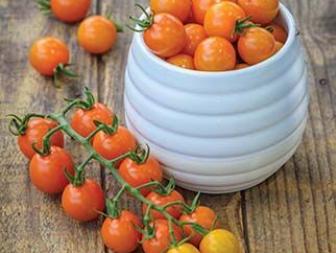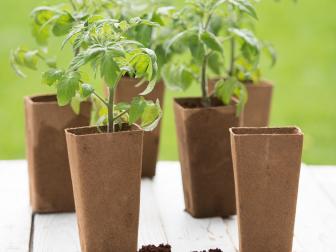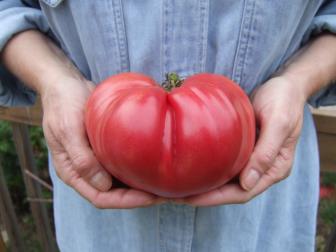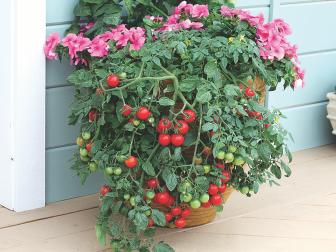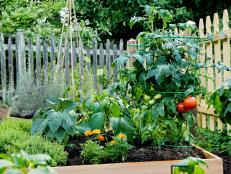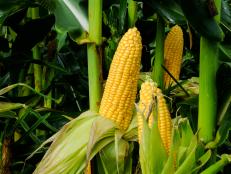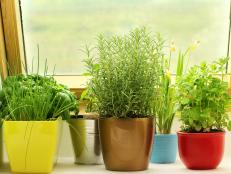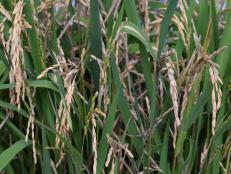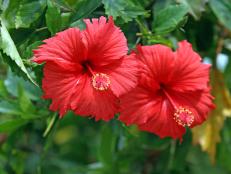How to Plant, Grow and Care for Tomatoes
Consider this your ultimate guide to choosing tomato plants, planting, growing and caring for tomatoes, and harvesting the best-tasting tomatoes ever.
Year after year, tomatoes top everyone's "what to grow" list. And no wonder: A tomato straight from the garden tastes far and away better than any tomato from the grocery store. In this guide, learn more about tomato plants and get expert advice on everything from choosing plants to planting, growing to troubleshooting and harvesting your tomatoes.
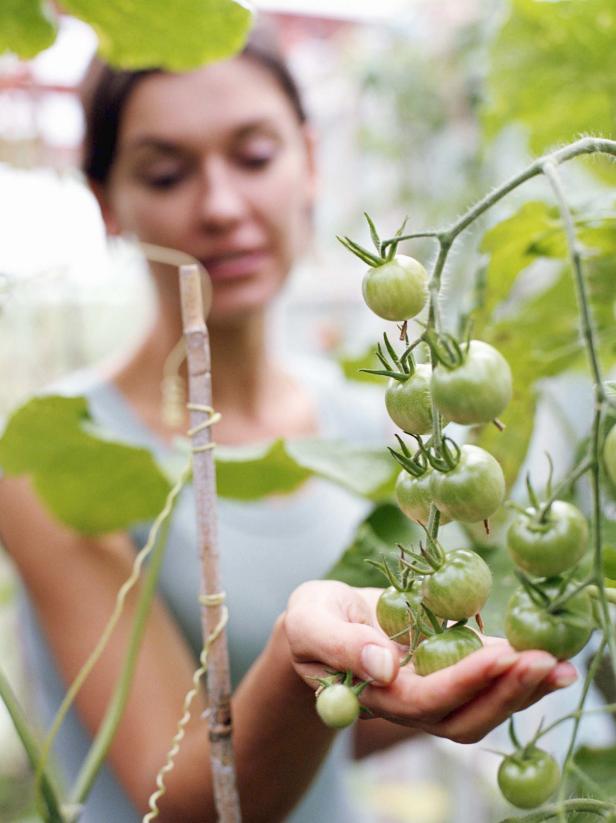
Choosing What Tomato Plants to Grow
Who knew choosing a tomato would be so complicated? Well, ask any seasoned gardener, and they'll tell you — it's a chore, albeit one we welcome year after year. Whether you grow your tomatoes from seed or start from tomato plants, there are so many varieties you can grow — at least 6,000 and counting — that the process of choosing may seem daunting. A little education on the types of tomato plants and the options and varieties available may help.
When shopping for tomato seeds or plants, consider the following factors:
- Plant growth habit
- Seed type
- Fruit size, color and flavor
- Disease resistance
- Regionality and climate suitability
Where to Buy Vegetable Plants Online
It's perfectly acceptable to grow many veggies and herbs from transplants instead of seed, and you can even order some online.
Plant Growth Habit
One major consideration in choosing which type of tomatoes to plant are their two distinct growth habits: determinate or indeterminate. Look for these words on seed packets, catalog descriptions and plant tags when shopping for tomato plants.
- Determinate varieties form bush-like plants with clusters of flowers at the ends of stems; these clusters stop plant growth so that all the fruit forms at relatively the same time. After several pickings, the plant is done and can be removed. While they are bushier than indeterminate plants, determinate plants may still need staking. Look for information about the expected height of the plant on seed packets or plant tags.
- Indeterminate varieties, grown on trellises or stakes, set clusters of fruit along a vining stem that grows all season, producing fruit until the first frost kills the plant. Many of these varieties can get very tall, and some gardeners prune them to keep the plants manageable.
While these are the two main growth habits, creative breeding has pushed the limits of plant form and structure to new heights — or, in the tomato's case, new lows. New varieties keep getting smaller and smaller to suit the needs of gardeners with small spaces and those who grow in containers. You might also see these words in descriptors:
- Compact: This indicates a determinate plant that stays very small — for example, around 12-18 inches tall and wide — with short, densely-leaved branches. Many compact varieties have cherry-sized fruit, though not all. They grow well in pots and don't need staking. You will also see these varieties called patio tomatoes.
- Tumbling: Similar to compact varieties, tumblers are great for containers but also have the added visual benefit of a trailing habit, meaning they can be used to spill over the sides of pots and window boxes.
Seed Type
As with most vegetables, tomato seed is available for both hybrid and heirloom varieties.
- Hybrids have been bred by cross-pollinating two parent varieties to create a new variety with desired characteristics such as disease resistance or plant height. In order to retain those desired characteristics, the seed must always be produced through cross-pollination, a form of human interference; you cannot save the seed from a hybrid and expect to get the same combination of traits in the next generation.
- Heirlooms have been passed down for at least 50 years, retaining relatively the same characteristics along the line. They often have interesting origins, colors and flavors, along with suitability to certain regions, but sometimes limited disease and pest resistance.
- Heirlooms are also open-pollinated, or OP, meaning that pollination occurs naturally in the field rather than being manipulated by human hands, such as cross-pollination. You will see some seed labeled as OP but not heirloom; that's because a variety could be open-pollinated but not have the historical lineage of an heirloom.
How Long Does It Take for Tomato Seeds to Germinate?
It’s important to understand germination when you’re starting tomato plants from seed. Know what to expect and how to troubleshoot if things don’t go quite as planned.
Fruit Size, Color and Flavor
These are important factors because they're about the end result: the tomato. Are you looking for a big slicer? Cherries you can pop in your mouth whole? Something for making tomato sauce? A beautiful tomato with surprising color? It's all available in the wide world of tomatoes; you just need to know what to look for.
There are three basic categories of tomatoes based on fruit size:
- Beefstake — large, round, juicy fruit, best for slicing
- Plum or Paste — oblong, fleshy fruit and rich flavors, best for making sauce
- Cherry — bite-sized fruit, typically very productive
Tomatoes come in a range of colors, from the classic red to orange, yellow, deep burgundy, purple and black, bright green and even white. Many of these colors are available in plants that are determinate or indeterminate, and fruit that's beefsteak, plum or cherry. If color is your primary decision point, look for that first, then narrow down by the other factors.
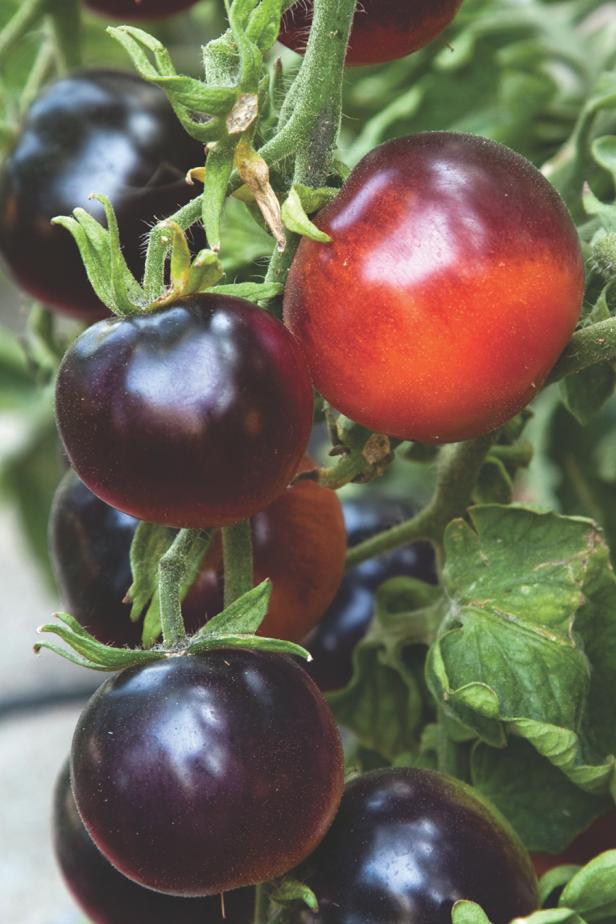
Image courtesy of JungSeed.com
'Indigo Rose' tomato features medium-sized, unusual purple fruits with a rosy red inner flesh and an acidic bite. The semi-determinate plants start producing in 75 to 80 days. Make sure to let the fruits fully ripen on the vine; watch for the skin to turn from a shiny purple to a duller, brown-purple and for the bottom of the fruits to change from green to red.
Flavor seems like it should be the first consideration, but it's only recently that connoisseurs have started talking about the nuance of tomato flavor. Some tomatoes are bright and tart while others are rich and exhibit that elusive fifth flavor: umami. (Hello, Cherokee Purple!) As you begin to grow your own and try out different varieties, you'll be amazed at the range of flavor tomatoes can offer, far beyond the grocery store varieties bred more for uniform size and shape, and transportability, than flavor.
Disease Resistance
While tomatoes always top every new gardener's list of what they want to grow, they can actually be quite complicated, and among the complicating factors are diseases and pests. The list of potential diseases includes:
- Anthracnose
- Early blight
- Late blight
- Fusarium wilt
- Septoria leaf spot
- Southern bacterial wilt
- Verticillium wilt
Do a little research to see if your area has problems with any of these diseases, and if so, look for varieties — most likely hybrids — that have shown resistance to the disease. You'll find this information listed in variety descriptions.
Regionality and Climate
Tomatoes will grow almost anywhere, but not all tomato varieties will grow well everywhere.
For gardeners in cooler, short-season zones — zones 5 and above — it's important to find varieties that grow and produce quickly and tolerate cool temperatures. These may be called early (Early Girl is the prime example), short-season, or cool-climate varieties, and you can also look at the "days to maturity" information. Tomatoes mature in a range from around 60 to 100 days; if your growing season is short, choose varieties on the faster end of that spectrum.
If you live in a particularly wet climate, it's likely that varieties with disease resistance will be your best bet, as most tomato diseases thrive in wet conditions. If you live in a hot, dry climate, look for varieties lauded for heat-tolerance; in many cases, the name will be a tip-off, such as Heat Master and Solar Fire.
Many heirloom varieties are beloved in particular regions of the country and known to grow well in those regions. If you're interested in heirlooms, look for seed sold by smaller, regional seed companies that specialize in varieties for your area.
Popular Varieties
As noted earlier, there are more than 6,000 varieties of tomatoes, so noting just a handful is a significant challenge, but these are a few well-known favorites to whet your appetite for more tomato research:
- Better Boy: Widely adapted hybrid indeterminate with great disease resistance and high yields of reliably round, red fruit.
- Cherokee Purple: Indeterminate heirloom passed down in the Cherokee tribe in Tennessee. Known for the deep red-purple color and rich taste.
- Early Girl: A popular indeterminate hybrid that matures first in gardens, hence the name "early."
- Pink Brandywine: Indeterminate heirloom, pink-fruited variety, passed down in Pennsylvania Amish communities. "Potato leaf" foliage looks more like potato plants (a cousin to tomatoes) than other tomato plants.
- Roma: Determinate plant grown for its fleshy fruit that's ideal for making tomato paste and sauce.
- Sweet 100: Indeterminate hybrid that produces literally hundreds of sweet red cherry fruit on one plant.
- Sungold: Hybrid indeterminate producing golden yellow cherry fruit with tangy flavor.

Potato-leaf tomato plants such as the heirloom Brandywine varieties have leaves with smooth, rather than serrated, edges. The leaf shape is also more oval and large-lobed than regular-leaf tomato varieties.
Planting Tomatoes
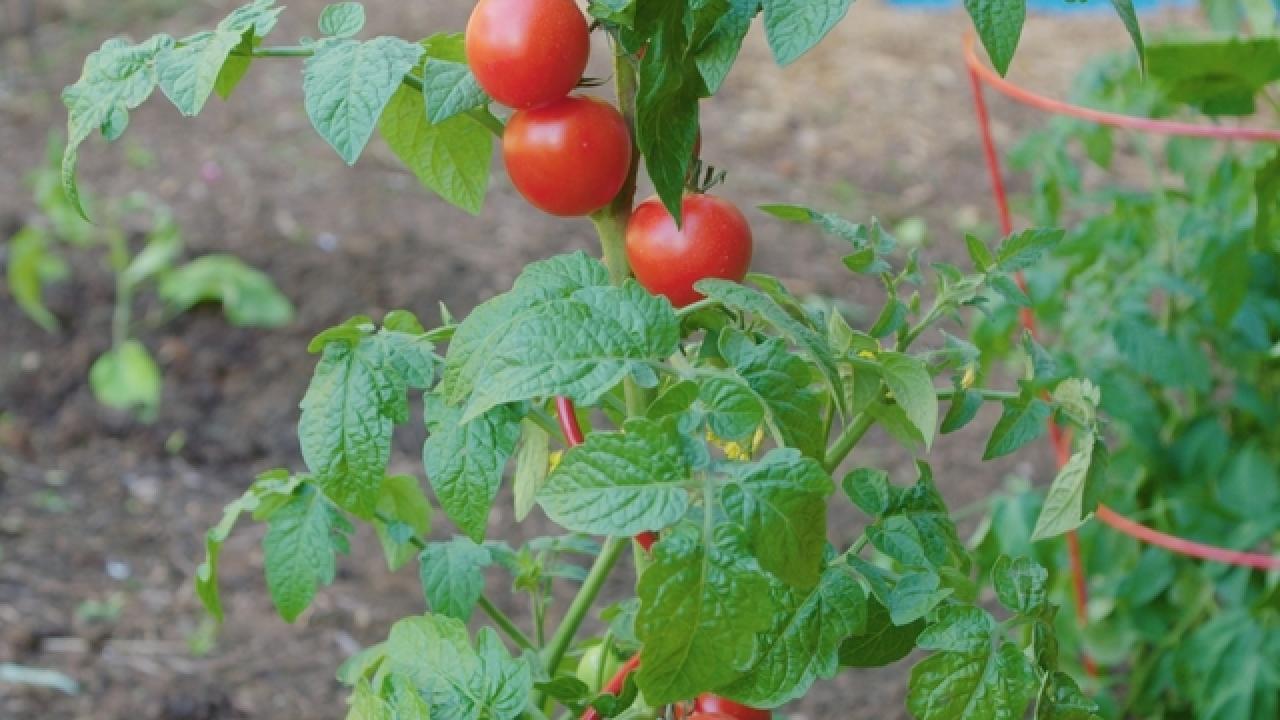
- You can start tomatoes from seed or from transplants. Starting from seed outdoors will take longer and may not provide enough time for fruit to mature in cooler climates, but you can start tomato seeds indoors and then transplant outdoors to allow more time.
- Tomato seeds should be started indoors 6-8 weeks before your last frost date in spring, which is the average date of last frosts in your area. This allows them time to grow into a healthy transplant before being moved outdoors.
- Plant tomatoes in a spot that gets at least 6 hours of sunlight a day, preferably more, and rich garden soil. Prepare soil by tilling or spading in composted organic matter and fertilizer such as 10-10-10.
- Whether you started it from seed or purchased at a garden center, plant tomato transplants in spring after all danger of frost has passed. If using transplants, plant at least to the depth of the cell in the container they came in, though many gardeners swear by planting tomatoes deeply — burying lower stems of the transplant underground, where they'll become strong roots.
- How far apart tomato plants should be planted depends on the variety. Space determinate plants two feet apart while indeterminates need more room, about 3 feet apart.
- Stake your tomato plants at planting time rather than waiting until the plant needs it. The support from a stake, trellis or tomato cage will keep the foliage and fruit off the ground. You'll absolutely have to stake the indeterminate types (the types that keep growing), but even determinate types benefit from staking.
- Apply mulch such as straw or cedar around the base of your plants to keep soil moisture even and to prevent soil splashing onto leaves that can lead to disease issues.
- When first planted, a tomato transplant — depending on your climate, humidity and type of soil — will need to be watered every couple of days. After it settles in, depending on climate, you can water less often.
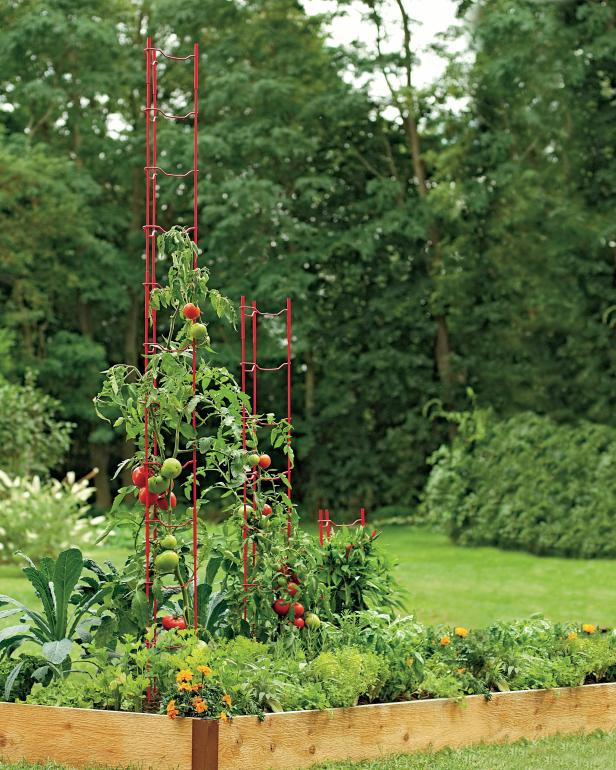
Image courtesy of Gardener's Supply
These tomato ladders can support over 100 pounds and are particularly effective because of their V-shaped design which protects plants from accidental breakage and strong winds.
Companion Plants
Tomatoes grow well alongside many other vegetable and herb garden plants. But, according to the new book Plant Partners by expert Jessica Walliser, some plant pairings have been scientifically proven to be beneficial for tomatoes. These include:
- Plant basil near tomatoes to mask tomato plants from thrips, an insect that spreads various plant diseases. Bonus: Basil and tomatoes taste great together!
- Grow carrot-family herbs such as dill, cilantro and fennel to control caterpillar pests, including tomato hornworm. The flowers of these herbs attract parasitic wasps that feed on hornworms and other caterpillar pests.
- Plant low-growing herbs such as thyme and leaf lettuce underneath tomato plants as a "living mulch" that shades the soil and prevents weeds while also providing a secondary crop in the same space.
Growing and Caring for Tomatoes
Caring for your tomato plants is a marathon, not a sprint; tomato plants can take three months or more to produce fruit, so you need to keep watch over your plants for the long haul. If you do, they'll reward you with prized late summer bounty.
Watering
Give your tomatoes a regular supply of moisture — 1 to 2 inches of water per week when they're fruiting. Tomatoes in containers may have to be watered every day or two. Inconsistent watering can lead to such problems as blossom end rot. The best advice is usually to water less often but deeply.
Fertilizing
Tomatoes are considered "heavy feeders," meaning they require a lot of nutrients to grow well. Feed lightly with a low-nitrogen fertilizer when the plant starts to flower. You can also apply a little compost around the plants as they mature.
Pruning
Regularly pinch off the new growth in the angle of the main stem and side branches — called the "suckers" — to keep the plant open and directing energy to fruiting stems.
10 Steps to Your Best Tomatoes Ever 10 Photos
Love tomatoes? Get ready for your best harvest yet, thanks to these easy-grows-it tips.
Growing Tomatoes in Pots
You can grow tomatoes in containers provided that the container is large enough for the variety of tomato.
- If you're growing a compact determinate variety, a smaller pot will do, but generally, tomato plants need containers at least 18-24 inches in diameter.
- Fill pots with good quality potting soil. Leave space for mulch, because container tomatoes need mulch, too.
- Water more often than you would a tomato plant in the ground. Containers dry out more quickly than ground; clay containers dry out the worst, so choose plastic or glazed clay for better results.
Easiest Vegetables to Grow in Flower Pots 9 Photos
It's easy to grow vegetables like tomatoes, lettuce, squash, strawberries and more in containers. Just be mindful of the size of your pots as well as your plants.
Common Problems and Solutions
Check your plants every few days and try to spot problems before they get out of hand. Here are a few common tomato problems and remedies:
- Blossom end rot is a plant disorder that spreads quickly, forming a black spot or indentation at the base, or blossom end, of the fruit. Typically caused by a calcium deficiency or inappropriate moisture, it cannot be treated with fungicides. Calcium amendments can be used, but don't expect a quick fix. Again, the best approach is prevention, including establishing a soil pH of about 6.5 for adequate calcium uptake and proper soil amendments.
- Spots on leaves can indicate a variety of diseases. When researching potential causes, you'll need to take note of the spot color, size and shape to help identify the exact disease, which may be caused by an insect pest or by climatic conditions such as wet weather, or a combination of both.
- Blossom drop happens when plants form flowers that drop off before fruiting, typically during hot weather when temperatures are consistently above 90 degree during the day. Keep plants healthy and wait until temperatures level out.
- Shiny or deformed leaves may be a sign of an insect issue, such as aphids, whiteflies or spider mites. Look for pear-shaped aphids on the undersides of leaves, thin webs of mites, or flies that move when plants are jostled. Insecticidal soap, applied according to package directions, is a good organic remedy.
- Plants not producing flowers or fruit may be getting too much nitrogen and putting all their energy into leaves.
- Cracked tomato fruit is caused by moisture fluctuations and most often occurs after a heavy rain. Harvest ripe fruits and maintain even watering to help alleviate this problem.
Harvesting and Storing Tips
Okay, now for the good stuff — harvesting and eating your tomatoes! When it's finally time to pick your tomatoes, here are a few tips to keep in mind:
- Leave your tomatoes on the plant until the fruit turns mostly the eventual color, whether red, orange or purple.
- Gently pull up on the fruit to separate it from the plant rather than pulling down on the fruit, which may harm branches.
- If tomatoes are getting eaten by squirrels or birds before you can pick them, or if frost threatens, you can harvest unripe tomatoes after they've started coloring up and ripen them indoors in a paper bag.
- Tomatoes shouldn't be refrigerated, which degrades the flavor and texture of garden-fresh fruit.
- Freezing tomatoes is a great way to preserve them. You can also make homemade canned tomato sauce.
Common Tomato Questions
How long does it take for tomatoes to grow?
How long it takes your tomato plant to grow and produce fruit depends on the variety. Some varieties are known as “short season” tomatoes because they produce more quickly, making them a good option for colder regions where the summer growing season is short. A clue may be in the name of the tomato, such as “Early Girl,” which matures as early as 50 days from planting. Most tomato varieties mature in the range of 60-85 days.
Can you plant tomatoes and peppers together?
Yes, tomatoes and peppers can be planted together, but with a caveat. They are both members of the Solanaceae, or Nightshade, plant family and are susceptible to the same pests and diseases. If you have an issue with pests or diseases on your peppers and tomatoes, you may want to separate them so you’re not creating a bullseye in your garden for particular problems. It is also beneficial to interplant flowers such as marigolds with your tomatoes and peppers to deter pests.
When to pick tomatoes?
Pick tomatoes when they have ripened to their mature color, which will depend on the variety you’re growing. They may be red, or they may be yellow, gold, purple or green, depending on the tomato variety. If you are having issues with birds or squirrels getting your tomatoes, or with cracking and splitting, you can harvest your tomatoes before they’ve fully ripened to the mature color and continue ripening them indoors in a paper bag. Just make sure the fruit has a little color on it before you pick it. If it’s totally green, it won’t ripen indoors.
Why are the leaves on my tomato plant curling?
A lot of problems can cause leaf curl, including aphids, which carry viruses. Look for them on the underside of the leaves before you do anything. If you see aphids, you can remove them with water from the hose sprayer and you can also apply insecticidal soap or neem oil according to the label instructions. Leaf curl can also be caused by heat, drought or a specific virus. Keep plants well-watered and provide plenty of nutrition through compost or organic fertilizer to keep plants healthy and able to withstand all of these challenges.
15 Fresh Tomato Recipes 16 Photos
Try one of these fresh tomato recipes to make use of your homegrown harvest this growing season.
13 Yummy Ways to Eat Green Tomatoes
Don’t let your unripe tomatoes go to waste. Food Network shares their best green tomato recipes.
More Grow Guides
- Planting and Growing Arugula
- How to Grow Asparagus
- How to Plant, Grow and Harvest Basil
- How to Plant and Grow Broccoli
- How to Grow Carrots
- How to Plant and Grow Onions
- Planting and Growing Eggplant
- How to Grow Celery
- Planting and Growing Spinach
- Planting and Growing Beets
- Planting and Growing Cabbage

.-Battle-on-the-Beach-courtesy-of-HGTV.-.jpg.rend.hgtvcom.196.196.suffix/1714761529029.jpeg)





